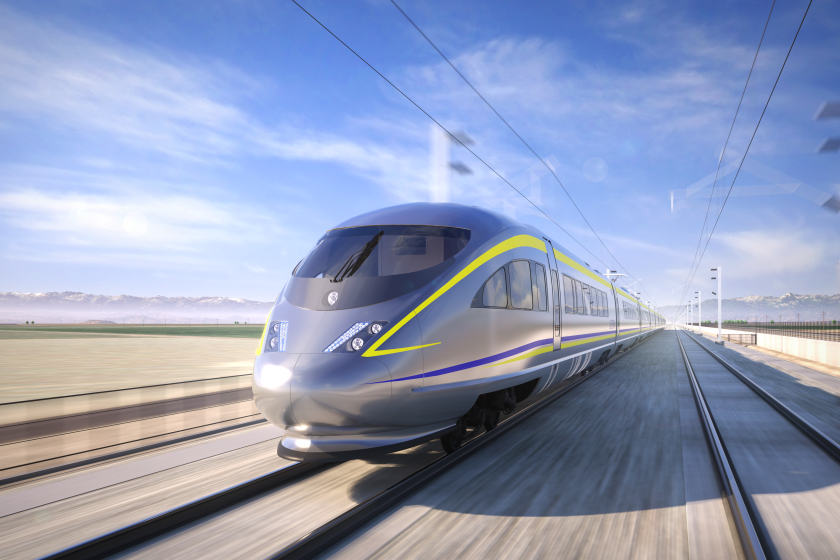Experts Hope Bridge Fall Won’t Delay Trolley Line
- Share via
Los Angeles County transit officials were cautiously optimistic Wednesday that the collapse of a partly completed 400-ton trolley bridge will not significantly delay the summer, 1990, scheduled opening of the first line of the region’s multibillion-dollar mass transit system.
While the cause of Tuesday morning’s spectacular accident was still to be determined, contractors were developing plans to make up construction time lost when the concrete trestle for the Los Angeles-to-Long Beach trolley fell onto Firestone Boulevard in an unincorporated area of South Los Angeles.
Eight people were injured, none seriously. They included two men who were trapped in a pickup truck that was crushed by the falling bridge, five bridge workers and a pedestrian.
Workers moved quickly to reopen the busy thoroughfare, which officials originally predicted might be blocked for three days. By early Wednesday morning, the 110-foot span had been broken up and removed and all four lanes were open to traffic.
Meanwhile, an interagency team of state and county engineers began a two-pronged investigation to determine the cause of the near-tragedy and to ensure that other bridge-building projects in the county are safe.
Attention focused on the timber-and-steel temporary structure that had supported the bridge. One transit official told The Times that, for no apparent reason, the temporary support structure, or “falsework,” appeared to shift several feet and toppled “like a domino.”
There was still no estimate of total damage Wednesday. But officials with the county Transportation Commission, which is building the trolley system, said their insurance would cover losses.
The $720-million, 22-mile Long Beach trolley, dubbed the Blue Line, is about 70% complete and will be the first in the system to carry passengers.
A segment from Long Beach to the southern edge of the Central City financial district is scheduled to open in July, 1990. A final leg, which will drop into a subway station beneath 7th and Flower streets in downtown Los Angeles, is not expected to open until 1991.
Connecting Links
The Blue Line will connect with the Metro Rail subway, or Red Line, and the Century Freeway trolley, or Green Line, which are both scheduled to open in 1993.
Tuesday’s bridge collapse was the largest mishap so far in the county’s ambitious mass transit construction program, which includes the RTD’s Metro Rail subway and the commission’s trolley lines that planners hope will some day extend for 150 miles. Thus far, the mass transit program’s problems mostly have been construction delays.
Last year, however, there was an embarrassing foul-up on another Long Beach trolley bridge being built across Compton Creek. Cracks developed in the surface of the bridge because steel reinforcing was placed improperly and commission inspectors did not catch it. The problem has since been corrected, with the contractor agreeing to pick up the added costs.
The investigation of Tuesday’s collapse--a mishap that engineering experts described as highly unusual--was expected to take several weeks. A task force of bridge experts and public works engineers from Caltrans, the county Public Works Department and the Transportation Commission was being assembled Wednesday.
“We’re going to get in there and do a thorough investigation and analysis of exactly what occurred,” said Ed McSpedon, the commission’s rail construction chief. “What we do know is that something unusual happened on that south abutment” where the trestle fell.
Temporary Structure
McSpedon has emphasized that it was a temporary support structure that failed, not the bridge itself. He noted that the span was “still very much intact” after the accident, he said.
Concerns about the quality of construction on the Firestone bridge contract, which includes two separate spans, were raised last year in an internal memo by a design engineer on the project.
Those concerns included possible soil settlement problems with a temporary support structure similar to the one that apparently failed Tuesday, as well as the need for field engineers to be more aggressive in enforcing contract requirements.
A Transportation Commission official insisted Wednesday that those concerns were addressed shortly after they were raised last year, as the first of the two spans was being built.
“All of the issues were responded to and reviewed,” said commission spokeswoman Erica Gobel. She said the memo was part of the “normal checks and balances” and “healthy dialogue” between engineers on such projects.
The engineer, who works for a consulting consortium hired by the commission, has declined to comment. He referred inquiries to the commission.
Gobel said it is the commission’s policy that its own officials, rather than contractors and their employees, respond to news media inquiries.
Morrison-Knudsen, the bridge contractor, also declined comment.
SURVIVOR’S STORY
“My only thought was to get out” after bridge collapsed on his vehicle, driver says. Page 8
More to Read
Sign up for Essential California
The most important California stories and recommendations in your inbox every morning.
You may occasionally receive promotional content from the Los Angeles Times.













